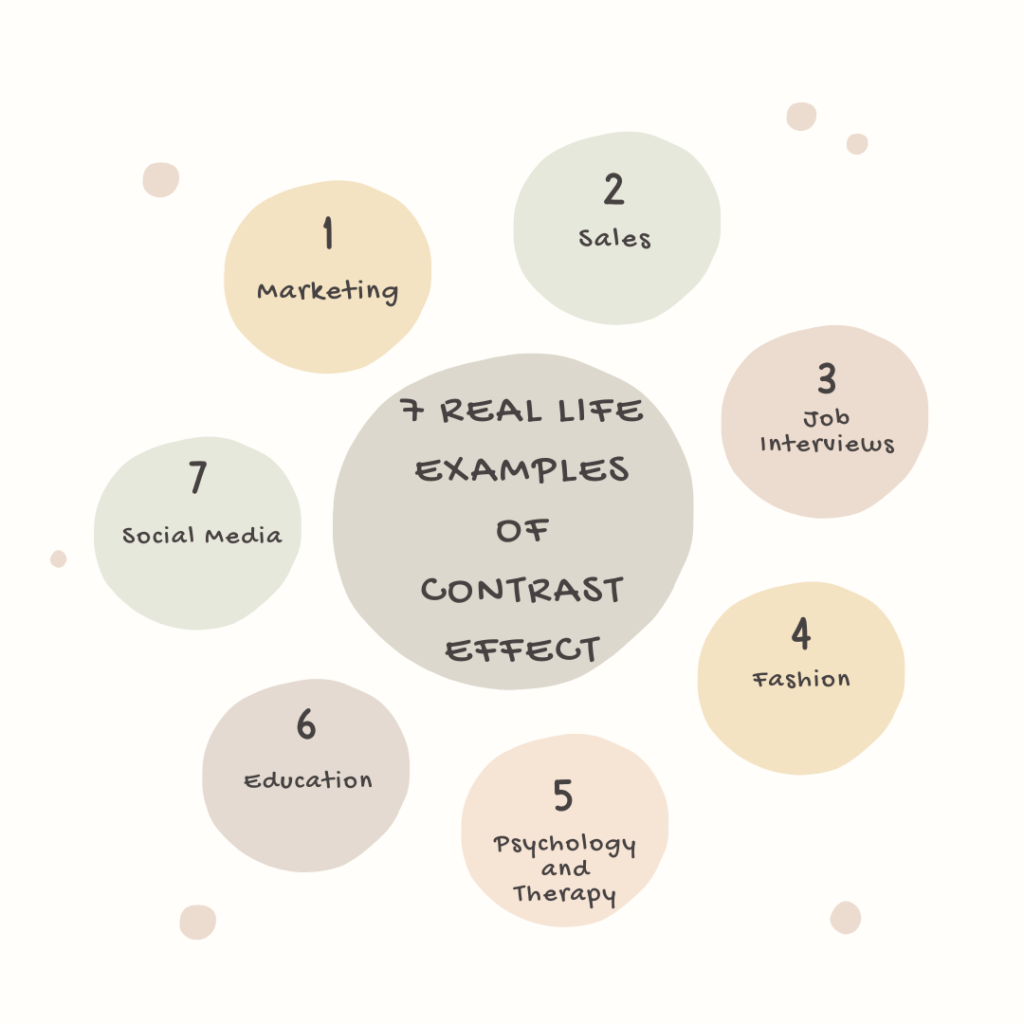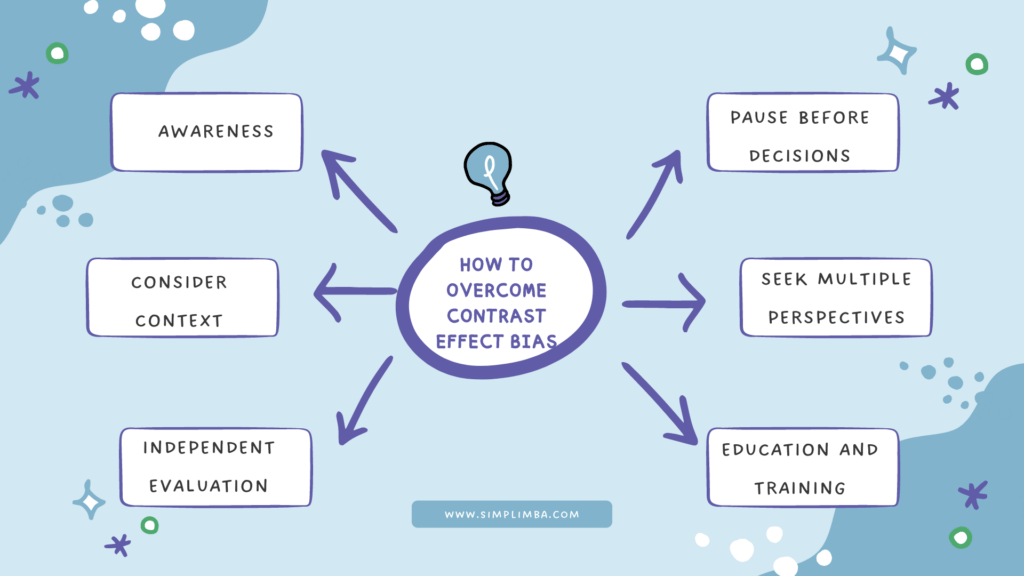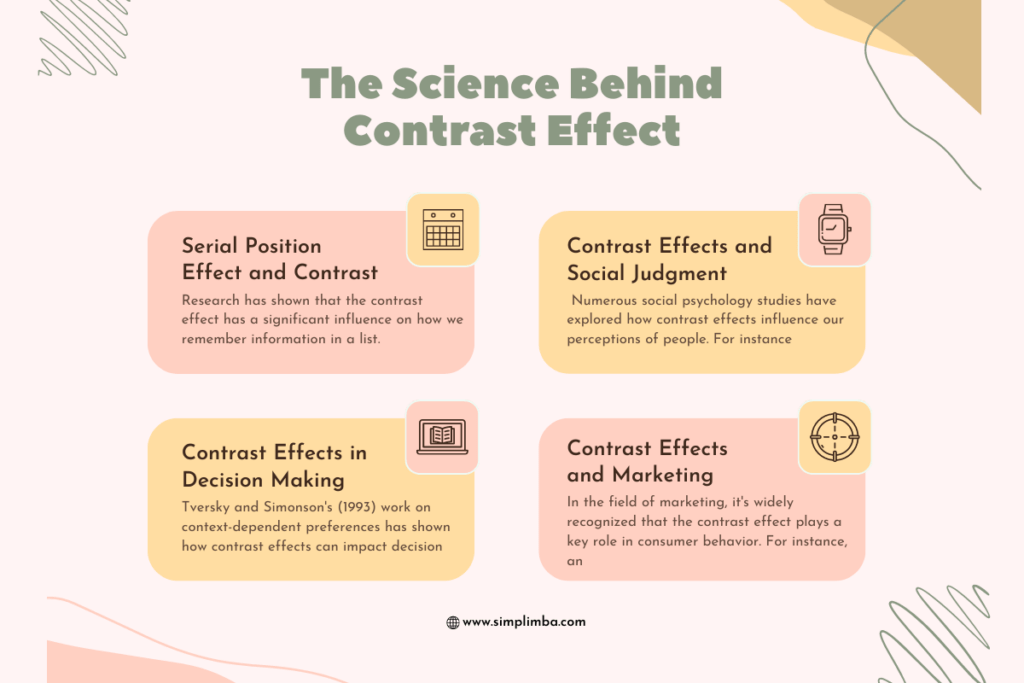Introduction
Contrast Effect: In our day-to-day lives, we constantly evaluate and compare things: whether choosing between brands at the supermarket, sizing up job offers, or even comparing ourselves to others on social media. Each time we make a judgment or decision, we’re influenced by an omnipresent psychological phenomenon known as the contrast effect. This phenomenon subtly molds our perceptions and decisions, often without us even realizing it, making it an integral yet unnoticed part of our lives.
The contrast effect is a cognitive bias that impacts how we perceive and judge things based on the context they’re presented in or what they’re compared against. Specifically, this bias can drastically alter our perception, making differences seem more significant or less significant than they truly are, purely based on what they’re juxtaposed with. The powerful impact of this bias is found in various fields, from marketing to recruitment, from social psychology to visual arts, making it a fascinating topic to delve into.
We have written about the 125 most common fallacies and biases that impact your decision-making. Read here.
Contrast effect definition
The contrast effect is a psychological principle that describes how our perception and understanding of something is influenced by the context in which it is presented or the things it is compared against. In essence, it occurs when the perceived value or quality of something changes drastically when it’s contrasted with something else, either better or worse. It is a form of relative perception and a powerful cognitive bias that often operates subconsciously, influencing our judgment, decision-making, and behavior.
The Psychology Behind Contrast Effect
Let’s do a thought Experiment to understand the Contrast Effect:
Imagine you’re shopping for a new smartphone. You start by looking at the most expensive models on the market, the latest iPhone and Samsung, each priced around $1000. While admiring their state-of-the-art features and sleek designs, you find them far beyond your budget. A sales assistant notices your hesitation and shows you another model, a decent mid-range smartphone priced at $500. Suddenly, this phone seems much more affordable and attractive, even if it lacks some of the features of the high-end models. This shift in perception is an example of the contrast effect. By comparing the mid-range phone to much more expensive models, it appears to be a more reasonable and attractive choice.
The contrast effect goes beyond just pricing or product comparisons. It applies to nearly every aspect of our lives, including our judgments of people, places, experiences, and even ourselves. For example, after a hard day at work, even a simple evening at home can seem extraordinarily relaxing. After viewing a very sad movie, a mildly happy one can seem overwhelmingly positive. In each case, our perception of the second experience is heightened due to the stark contrast with the initial experience.
The key takeaway from this thought experiment is to recognize that our judgments and perceptions are often relative rather than absolute. They are heavily influenced by context and the comparison set we use, whether we’re conscious of this or not. This realization can help us understand the sway of the contrast effect and how it shapes our thoughts, feelings, and actions.
We have written about the 125 most common fallacies and biases that impact your decision-making. Read here.
The Science Behind Contrast Effect: An Academic Perspective
Numerous academic studies have been conducted to understand the mechanisms and implications of the contrast effect, drawing from disciplines like psychology, cognitive science, and behavioral economics. Here are some of the notable findings:

Serial Position Effect and Contrast: Research has shown that the contrast effect has a significant influence on how we remember information in a list. This phenomenon, known as the serial position effect, states that we are most likely to remember the first and last items in a series, and this memory can be influenced by the contrast effect. For example, an average item might be remembered as being excellent if it follows several poor items (Murphy, Kelly, & Craig, 2016).
Contrast Effects and Social Judgment: Numerous social psychology studies have explored how contrast effects influence our perceptions of people. For instance, Kenrick and Gutierres (1980) found that men rated a potential date as less attractive after being exposed to a TV program featuring beautiful women. This study demonstrates the contrast effect in social contexts, illustrating how our perceptions of people are influenced by those we’ve recently encountered.
Contrast Effects in Decision Making: Tversky and Simonson’s (1993) work on context-dependent preferences has shown how contrast effects can impact decision-making. They found that the introduction of a third, less desirable option (a ‘decoy’) could make one of the original options seem more attractive, influencing the final decision.
Contrast Effects and Marketing: In the field of marketing, it’s widely recognized that the contrast effect plays a key role in consumer behavior. For instance, an expensive item can make a less costly one seem like a great deal, even if it’s not the cheapest option available (Doyle, O’Connor, Reynolds, & Bottomley, 1999).
Negative Contrast Effect Vs Positive Contrast Effective
| Negative Contrast Effect | Positive Contrast Effect | |
| Definition | The negative contrast effect occurs when an object or subject is evaluated less favorably because it is compared with a superior object or subject. | The positive contrast effect happens when an object or subject is evaluated more favorably because it is compared with an inferior object or subject. |
| Example | If you have just tasted a gourmet chocolate bar, a regular chocolate bar consumed afterwards may seem less tasty than usual. This is a negative contrast effect as the ordinary chocolate bar is evaluated less favorably due to the superior comparison (the gourmet chocolate bar). | If you have just tasted a poor quality chocolate bar, a regular chocolate bar consumed afterwards may seem more delicious than usual. This is a positive contrast effect as the ordinary chocolate bar is evaluated more favorably due to the inferior comparison (the poor-quality chocolate bar). |
| Impact | The negative contrast effect can decrease the perceived value of a subject or object when it follows a superior one. It can affect individual self-esteem, product evaluations, performance assessments, etc. | The positive contrast effect can increase the perceived value of a subject or object when it follows an inferior one. It can be used to enhance product attractiveness, motivate behavior, improve perceived performance, etc. |
| Manipulation | Sometimes used in social psychology to demonstrate the impact of high standards or exceptional performance on subsequent judgments. | Often used in marketing to make products or services seem more appealing, such as placing a moderately priced item next to more expensive ones to make it seem like a better deal. |
7 Real-Life Examples of Contrast Effect

Marketing
In the world of marketing, the contrast effect is a powerful tool that professionals employ to sway consumer perceptions. Consider a scenario in a retail store, where a particularly high-end item is strategically placed next to more affordable ones. This pricy item serves as a benchmark, making the less expensive items appear far more affordable in comparison. When contrasted with the luxury item, the cheaper ones suddenly become more appealing, despite the fact that their price hasn’t changed. They seem like a bargain, and consumers are more likely to perceive them as such and make a purchase.
Sales
The real estate industry offers another brilliant example of the contrast effect in action. Imagine a real estate agent showing potential buyers around several properties. They might start with properties that have obvious flaws or are less desirable for other reasons. When they then show a more appealing property, this property’s attractiveness is heightened in contrast to the previous properties. It appears far superior, making it more likely that the potential buyers will opt for it.
Job Interviews
The sequence of candidates in job interviews can also be influenced by the contrast effect. Suppose a hiring manager interviews a highly impressive candidate first. Any average candidate interviewed subsequently may seem less competent due to the stark contrast with the initial exceptional candidate. On the flip side, if the manager starts with candidates whose skills are clearly lacking, an average candidate may seem like a much stronger choice when interviewed afterward.
Fashion
The contrast effect is also at play when shopping for clothes. If you try on a dress that is a size too big, your actual size will seem significantly smaller when you try it on next. The over-sized dress creates a contrast that influences your perception of the fit of the correctly sized dress. This can, in turn, boost consumer satisfaction and influence purchasing decisions.
Psychology and Therapy
In the realm of psychology, particularly in cognitive behavioral therapy, therapists use the contrast effect to help patients cope with their problems. By encouraging patients to recall happy memories or positive experiences during times of distress, the current issues may seem less daunting by comparison. This relative perception can foster resilience and aid in the therapy process.
Education
In an educational setting, the contrast effect can influence the grading process. For example, a teacher might be grading a stack of essays. If they start with several outstanding ones, the first average essay they encounter might receive a lower grade than it would have if it had been evaluated independently. This is because the excellence of the initial essays creates a tough act to follow, making the subsequent average essay seem lacking in comparison.
Social Media
In the digital era, social media platforms are ripe for the contrast effect. When scrolling through social media feeds, users often encounter profiles of people who appear extraordinarily successful, fit, or happy. This creates a contrasting backdrop that can make their own lives feel less satisfactory. The glamorous life others seem to lead can make users feel like their own lives are mundane or unfulfilling, contributing to feelings of inadequacy or unhappiness.
We have written about the 125 most common fallacies and biases that impact your decision-making. Read here.
Difference between contrast effect and assimilation effect
| Contrast Effect | Assimilation Effect | |
| Definition | The contrast effect occurs when our perception of something is influenced by a stark comparison, causing it to appear more different than it is in reality. | The assimilation effect occurs when our perception of something is pulled towards a preceding or surrounding stimulus, causing it to appear more similar than it is in reality. |
| Example | If you lift a heavy box and then lift a lighter one, the lighter box will feel even lighter than it actually is. This is the contrast effect— the lighter box seems lighter due to the contrast with the heavy box. | If you’re in a room where everyone is taller than you, you might perceive yourself as shorter than you actually are. This is the assimilation effect— you perceive yourself to be more similar to those around you (taller people), so you feel shorter. |
| Impact | The contrast effect can make differences seem more significant or exaggerated, and it plays a crucial role in various fields, from marketing to social psychology. | The assimilation effect can make differences seem less significant or downplayed, and it can impact areas like social dynamics, group conformity, and stereotype enforcement. |
| Usage | The contrast effect is often utilized in sales and marketing to make products seem more appealing by comparing them to less attractive options. | The assimilation effect is often observed in social scenarios where individuals tend to conform to group norms, characteristics, or behaviors. |
Social Judgment Theory and Contrast Effect: A Role in Perception
Social Judgment Theory (SJT), developed by psychologist Muzafer Sherif, provides a framework for understanding how people form opinions or judgments, particularly around socially significant or controversial topics. According to SJT, when we encounter a new idea, we compare it to our existing beliefs or attitudes, which fall into three categories: the latitude of acceptance (beliefs we agree with), the latitude of non-commitment (beliefs we are neutral towards), and the latitude of rejection (beliefs we disagree with).
The contrast effect plays a significant role within this theory, particularly when it comes to interpreting information that falls within our latitude of rejection. When we come across information that sharply contradicts our own beliefs, we are likely to perceive it as more different or more extreme than it actually is due to the contrast with our existing attitudes. This is the contrast effect at work in the context of social judgment theory.
For instance, if an individual strongly opposes the idea of climate change, they might interpret moderate evidence supporting climate change as being very extreme, simply because it is so different from their current belief. The difference between the new information and their existing belief is exaggerated due to the contrast effect, making the new information seem further away from their current standpoint than it really is.
Understanding this phenomenon is crucial when attempting to communicate or persuade on divisive topics. If the information is too far removed from a person’s existing beliefs, the contrast effect might lead them to perceive it as more extreme, and they might reject it outright. To avoid this, communicators might aim to present information that falls near the edge of the listener’s latitude of acceptance or within their latitude of non-commitment, which could lead to a shift in their perception over time.
We have written about the 125 most common fallacies and biases that impact your decision-making. Read here.
How to overcome Contrast Effect Bias
Overcoming the contrast effect bias involves increasing your awareness of how it operates and consciously adjusting your judgments and decisions to mitigate its influence. Here are a few strategies to help you overcome this bias:

Awareness: The first step towards mitigating any cognitive bias is awareness. Understand what the contrast effect is and how it can potentially influence your decisions. By being aware of it, you can be on the lookout for situations where it might be at play.
Consider Context: Always be mindful of the context in which you’re making a judgment or decision. If there is a high likelihood for the contrast effect to occur (like during a sequence of interviews or when comparing products), keep in mind that your perception may be influenced by the contrasting information.
Independent Evaluation: Wherever possible, try to make evaluations independently. For example, assess each job candidate or each product on its own merits rather than comparing it with others. This can help to reduce the influence of the contrast effect.
Pause Before Decisions: Taking a pause before making a decision allows you to reassess the information without immediate comparisons. During this pause, try to reflect on the qualities of the choice itself, without regard to other contrasting elements.
Seek Multiple Perspectives: Another way to overcome the contrast effect is to seek input from others. Different people might have different contrasting standards, and this variety of perspectives can provide a more holistic view.
Education and Training: Regular training and education about cognitive biases, including the contrast effect, can help individuals in your organization or team make more balanced decisions. This is particularly relevant in settings like HR and marketing, where the contrast effect can significantly impact outcomes.
Conclusion
The contrast effect is a fascinating psychological phenomenon that significantly influences our perceptions, judgments, and decision-making processes. It plays a crucial role in a variety of realms, from marketing and sales to job interviews, education, and social media. Its influence on our daily lives, though often subtle and unnoticed, is profound and pervasive.
The contrast effect also intertwines with other psychological concepts like the Social Judgment Theory, impacting how we perceive and process information, especially when it comes to our existing beliefs and attitudes. Understanding the contrast effect helps us to not only navigate the world more effectively but also to communicate and persuade more successfully.
As we peel back the layers of this phenomenon, we uncover the ways in which our minds strive to make sense of the world around us. Awareness of the contrast effect allows us to recognize and analyze its impact, equipping us with the tools to make more informed and less biased decisions. It’s a testament to the complexities and wonders of human cognition, reminding us of the relative nature of our perceptions.
So, the next time you find an average chocolate bar surprisingly delightful after a poor one, or an item more appealing when placed next to an expensive one, remember: it’s not just you, it’s the power of the contrast effect at work!
Samrat is a Delhi-based MBA from the Indian Institute of Management. He is a Strategy, AI, and Marketing Enthusiast and passionately writes about core and emerging topics in Management studies. Reach out to his LinkedIn for a discussion or follow his Quora Page

